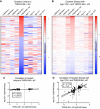Impact of scaffolding protein TNRC6 paralogs on gene expression and splicing
- PMID: 34108231
- PMCID: PMC8370741
- DOI: 10.1261/rna.078709.121
Impact of scaffolding protein TNRC6 paralogs on gene expression and splicing
Abstract
TNRC6 is a scaffolding protein that bridges interactions between small RNAs, argonaute (AGO) protein, and effector proteins to control gene expression. There are three paralogs in mammalian cells, TNRC6A, TNRC6B, and TNRC6C These paralogs have ∼40% amino acid sequence identity and the extent of their unique or redundant functions is unclear. Here, we use knockout cell lines, enhanced crosslinking immunoprecipitation (eCLIP), and high-throughput RNA sequencing (RNA-seq) to explore the roles of TNRC6 paralogs in RNA-mediated control of gene expression. We find that the paralogs are largely functionally redundant and changes in levels of gene expression are well-correlated with those observed in AGO knockout cell lines. Splicing changes observed in AGO knockout cell lines are also observed in TNRC6 knockout cells. These data further define the roles of the TNRC6 isoforms as part of the RNA interference (RNAi) machinery.
Keywords: Argonaute; GW182; RNA interference; RNA sequencing; TNRC6; alternative splicing.
© 2021 Johnson et al.; Published by Cold Spring Harbor Laboratory Press for the RNA Society.
Figures







References
Publication types
MeSH terms
Substances
Grants and funding
LinkOut - more resources
Full Text Sources
Molecular Biology Databases
